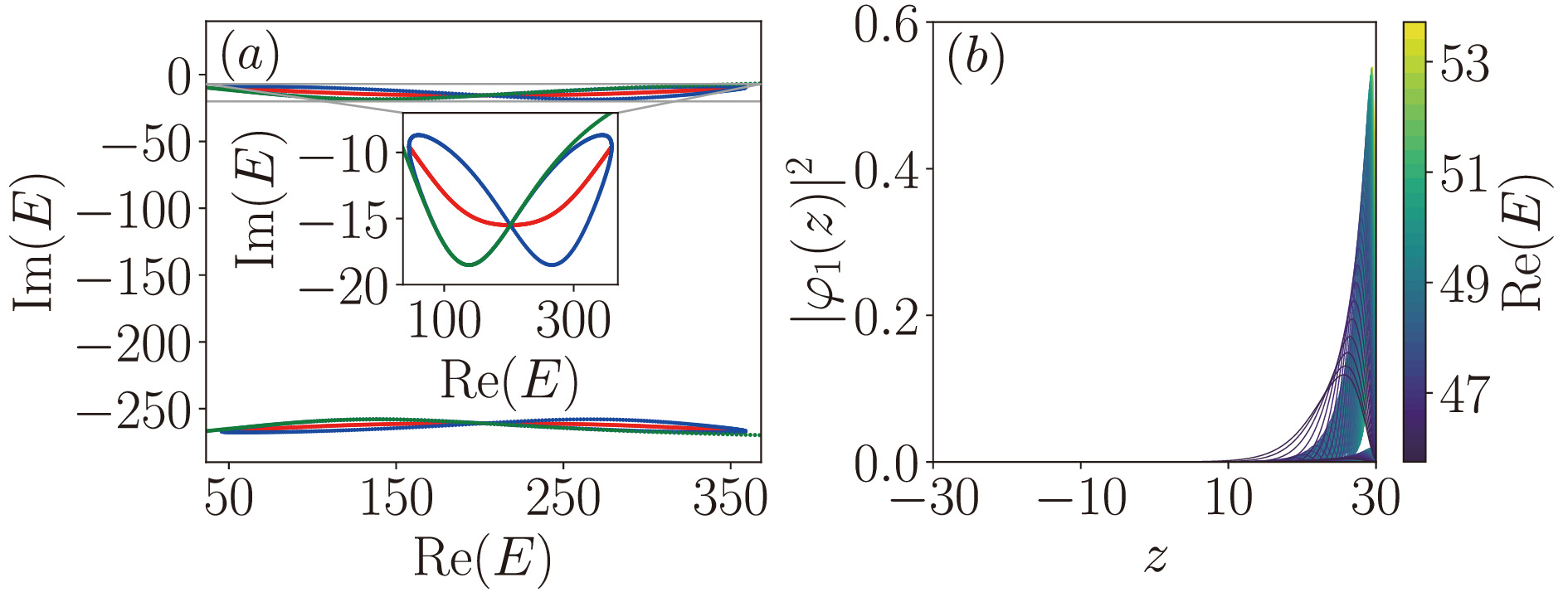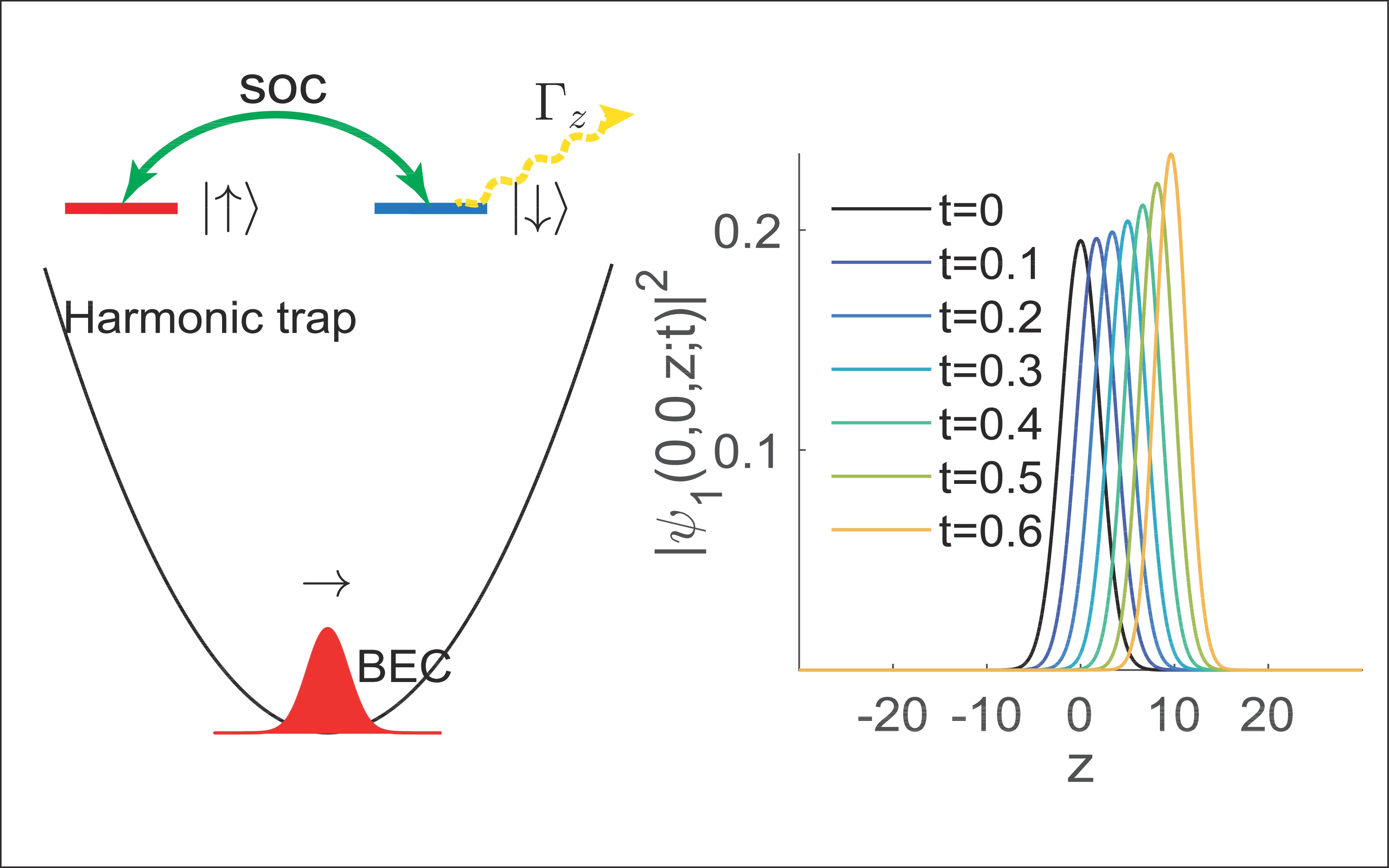
ISSN 0253-2778
CN 34-1054/N
We study a Bose-Einstein condensate of ultracold atoms subject to a non-Hermitian spin-orbit coupling, where the system acquires the non-Hermitian skin effect under the interplay of spin-orbit coupling and laser-induced atom loss. The presence of the non-Hermitian skin effect is confirmed through its key signatures in terms of the spectral winding under the periodic boundary condition, the accumulation of eigen wavefunctions at boundaries under an open boundary condition, and bulk dynamics signaled by a directional flow. We show that bulk dynamics, in particular, serves as a convenient signal for experimental detection. The impact of interaction and trapping potentials is also discussed based on the non-Hermitian Gross-Pitaevskii equations. Our work demonstrates that the non-Hermitian skin effect and its rich implications in topology, dynamics, and beyond are well within the reach of current cold-atom experiments.

Directional flow in a trapped, dissipative Bose-Einstein condensate (BEC) signals the non-Hermitian skin effect.
Figure
1.
(a) Single-particle eigenspectra of Hamiltonian (1) on the complex plane. Green: eigenspectrum of in the momentum space (an infinite system under PBC). Blue: eigenspectrum of a finite system with
Figure
2.
(a) Propagation of the condensate wavefunction in the bulk, with
Figure
3.
(a, d) Spatial distribution of eigen wavefunctions along the
Figure
4.
Effect of condensate interaction on the non-Hermitian skin effect in a trapped gas, evaluated at
| [1] |
Yao S, Wang Z. Edge states and topological invariants of non-Hermitian systems. Phys. Rev. Lett., 2018, 121: 086803. DOI: 10.1103/PhysRevLett.121.086803
|
| [2] |
Yao S, Song F, Wang Z. Non-Hermitian Chern bands. Phys. Rev. Lett., 2018, 121: 136802. DOI: 10.1103/PhysRevLett.121.136802
|
| [3] |
Yokomizo K, Murakami S. Non-Bloch band theory of non-Hermitian systems. Phys. Rev. Lett., 2019, 123: 066404. DOI: 10.1103/PhysRevLett.123.066404
|
| [4] |
Lee C H, Thomale R. Anatomy of skin modes and topology in non-Hermitian systems. Phys. Rev. B, 2019, 99: 201103. DOI: 10.1103/PhysRevB.99.201103
|
| [5] |
Kunst F K, Edvardsson E, Budich J C, et al. Biorthogonal bulk-boundary correspondence in non-Hermitian systems. Phys. Rev. Lett., 2018, 121: 026808. DOI: 10.1103/PhysRevLett.121.026808
|
| [6] |
McDonald A, Pereg-Barnea T, Clerk A A. Phase-dependent chiral transport and effective non-Hermitian dynamics in a Bosonic Kitaev-Majorana chain. Phys. Rev. X, 2018, 8: 041031. DOI: 10.1103/PhysRevX.8.041031
|
| [7] |
Martinez Alvarez V M, Barrios Vargas J E, Foa Torres L E F. Non-Hermitian robust edge states in one dimension: Anomalous localization and eigenspace condensation at exceptional points. Phys. Rev. B, 2018, 97: 121401. DOI: 10.1103/PhysRevB.97.121401
|
| [8] |
Zhang K, Yang Z, Fang C. Correspondence between winding numbers and skin modes in non-Hermitian systems. Phys. Rev. Lett., 2020, 125: 126402. DOI: 10.1103/PhysRevLett.125.126402
|
| [9] |
Okuma N, Kawabata K, Shiozaki K, et al. Topological origin of non-Hermitian skin effects. Phys. Rev. Lett., 2020, 124: 086801. DOI: 10.1103/PhysRevLett.124.086801
|
| [10] |
Yang Z, Zhang K, Fang C, et al. Non-Hermitian bulk-boundary correspondence and auxiliary generalized Brillouin zone theory. Phys. Rev. Lett., 2020, 125: 226402. DOI: 10.1103/PhysRevLett.125.226402
|
| [11] |
Longhi S. Probing non-Hermitian skin effect and non-Bloch phase transitions. Phys. Rev. Research, 2019, 1: 023013. DOI: 10.1103/PhysRevResearch.1.023013
|
| [12] |
Deng T S, Yi W. Non-Bloch topological invariants in a non-Hermitian domain wall system. Phys. Rev. B, 2019, 100: 035102. DOI: 10.1103/PhysRevB.100.035102
|
| [13] |
Li L, Lee C H, Mu S, et al. Critical non-Hermitian skin effect. Nat. Commun., 2020, 11: 5491. DOI: 10.1038/s41467-020-18917-4
|
| [14] |
Song F, Yao S, Wang Z. Non-Hermitian skin effect and chiral damping in open quantum systems. Phys. Rev. Lett., 2019, 123: 170401. DOI: 10.1103/PhysRevLett.123.170401
|
| [15] |
Longhi S. Unraveling the non-Hermitian skin effect in dissipative systems. Phys. Rev. B, 2020, 102: 201103. DOI: 10.1103/PhysRevB.102.201103
|
| [16] |
Helbig T, Hofmann T, Imhof S, et al. Generalized bulk–boundary correspondence in non-Hermitian topolectrical circuits. Nat. Phys., 2020, 16: 747–750. DOI: 10.1038/s41567-020-0922-9
|
| [17] |
Xiao L, Deng T S, Wang K K, et al. Non-Hermitian bulk–boundary correspondence in quantum dynamics. Nat. Phys., 2020, 16: 761–766. DOI: 10.1038/s41567-020-0836-6
|
| [18] |
Xiao L, Deng T S, Wang K K, et al. Observation of non-Bloch parity-time symmetry and exceptional points. Phys. Rev. Lett., 2021, 126: 230402. DOI: 10.1103/PhysRevLett.126.230402
|
| [19] |
Ghatak A, Brandenbourger M, van Wezel J, et al. Observation of non-Hermitian topology and its bulk-edge correspondence in an active mechanical metamaterial. Proc. Natl. Ac. Sc., 2020, 117: 29561–29568. DOI: 10.1073/pnas.2010580117
|
| [20] |
Hofmann T, Helbig T, Schindler F, et al. Reciprocal skin effect and its realization in a topolectrical circuit. Phys. Rev. Research, 2020, 2: 023265. DOI: 10.1103/PhysRevResearch.2.023265
|
| [21] |
Weidemann S, Kremer M, Helbig T, et al. Topological funneling of light. Science, 2020, 368: 311–314. DOI: 10.1126/science.aaz8727
|
| [22] |
Zhou L, Li H, Yi W, et al. Engineering non-Hermitian skin effect with band topology in ultracold gases. [2022-01-10]. https://arxiv.org/abs/2111.04196.
|
| [23] |
Guo S, Dong C, Zhang F, et al. Theoretical prediction of non-Hermitian skin effect in ultracold atom systems.[2022-01-10]. https://arxiv.org/abs/2111.04220.
|
| [24] |
Lin Y J, Jiménez-García K, Spielman I B. Spin-orbit-coupled Bose-Einstein condensates. Nature, 2011, 471: 83–86. DOI: 10.1038/nature09887
|
| [25] |
Zhang J Y, Ji S C, Chen Z, et al. Collective dipole oscillations of a spin-orbit coupled Bose-Einstein condensate. Phys. Rev. Lett., 2012, 109: 115301. DOI: 10.1103/PhysRevLett.109.115301
|
| [26] |
Wang P, Yu Z Q, Fu Z, et al. Spin-orbit coupled degenerate Fermi gases. Phys. Rev. Lett., 2012, 109: 095301. DOI: 10.1103/PhysRevLett.109.095301
|
| [27] |
Cheuk L W, Sommer A T, Hadzibabic Z, et al. Spin-injection spectroscopy of a spin-orbit coupled Fermi gas. Phys. Rev. Lett., 2012, 109: 095302. DOI: 10.1103/PhysRevLett.109.095302
|
| [28] |
Huang L, Meng Z, Wang P, et al. Experimental realization of two-dimensional synthetic spin-orbit coupling in ultracold Fermi gases. Nat. Phys., 2016, 12: 540–544. DOI: 10.1038/nphys3672
|
| [29] |
Wu Z, Zhang L, Sun W, et al. Realization of two-dimensional spin-orbit coupling for Bose-Einstein condensates. Science, 2016, 354: 83–88. DOI: 10.1126/science.aaf6689
|
| [30] |
Zhang L, Liu X J. Chapter 1: Spin-orbit coupling and topological phases for ultracold atoms. In: Synthetic Spin-Orbit Coupling in Cold Atoms. Singapore: World Scientific, 2018: 1–87.
|
| [31] |
Galitski V, Spielman I B. Spin-orbit coupling in quantum gases. Nature, 2013, 494: 49–54. DOI: https://doi.org/10.1038/nature11841
|
| [32] |
Goldman N, Juzeliūnas G, Öhberg P, et al. Light-induced gauge fields for ultracold atoms. Rep. Prog. Phys., 2014, 77: 126401. DOI: 10.1088/0034-4885/77/12/126401
|
| [33] |
Zhai H. Degenerate quantum gases with spin-orbit coupling: A review. Rep. Prog. Phys., 2015, 78: 026001. DOI: 10.1088/0034-4885/78/2/026001
|
| [34] |
Yi W, Zhang W, Cui X. Pairing superfluidity in spin-orbit coupled ultracold Fermi gases. Sci. China Phys. Mech. Astron., 2015, 58: 1–11. DOI: 10.1007/s11433-014-5609-8
|
| [35] |
Zhang J, Hu H, Liu X J, et al. Chapter 2: Fermi gases with synthetic spin-orbit coupling. In: Annual Review of Cold Atoms and Molecules: Volume 2. Singapore: World Scientific, 2014: 81–143.
|
| [36] |
Ren Z, Liu D, Zhao E, et al. Chiral control of quantum states in non-Hermitian spin-orbit-coupled fermions. Nat. Phys., 2022, 18: 385–389. DOI: 10.1038/s41567-021-01491-x
|
| [37] |
Li J, Harter A K, Liu J, et al. Observation of parity-time symmetry breaking transitions in a dissipative Floquet system of ultracold atoms. Nat. Commun., 2019, 10: 855. DOI: 10.1038/s41467-019-08596-1
|
| [38] |
Lin Q, Li T, Xiao L, et al. Observation of non-Hermitian topological Anderson insulator in quantum dynamics. Nat. Commun., 2022, 13: 3229. DOI: 10.1038/s41467-022-30938-9
|
| [39] |
Carmichael H J. Quantum trajectory theory for cascaded open systems. Phys. Rev. Lett., 1993, 70: 2273–2276. DOI: 10.1103/PhysRevLett.70.2273
|